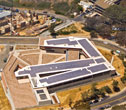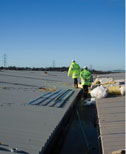During the past 15 years, reflective, or "cool," roofs have been promoted as an effective way for building owners to save energy and lower utility costs while reducing a building's carbon footprint. The belief white roofs always are the most environmentally friendly and energy-efficient choice is widely accepted. There are even white roofing mandates for commercial buildings at the state and local government levels. Cool roofs are seen as a quick, low-cost solution to reduce global carbon emissions, in turn affecting climate change. However, cool roofs are not a quick fix for climate change and may actually increase energy consumption in certain climates.
Cool roofing promotion
Adding to the popular belief reflective roofing is a quick fix for climate change and the best way to achieve energy savings, institutions and researchers have promoted reflective roofing regardless of geographic location. Cool roofing has been touted as an easily attainable method for achieving energy savings, climate zone or insulation levels notwithstanding.
Despite the promotion of the cool roof concept, roofing professionals know different geographic areas, climates and weather conditions require different types of roof systems. Despite what theories may suggest, there is not a one-size-fits-all roofing solution for energy savings.
Rethinking cool roofs
Reflective, or cool, roofs have been proven to contribute to energy savings in warm, southern climates by reducing air-conditioning costs during hot summer months. It makes good financial sense cool roofs would be popular in these areas. However, in cooler, northern climates where building owners typically spend five times more money heating their buildings than cooling them, a reflective roof actually can increase energy consumption and, therefore, increase carbon emissions.
A great deal of the belief reflective roofs are a universal remedy for energy savings comes from studies performed at the Berkeley, Calif.-based Lawrence Berkeley National Laboratory during the late 1990s and early 2000s, which purportedly showed the energy-saving benefits of using white reflective roof systems in any climate, including northern climates.
However, a more recent, comprehensive 2010 study supported by National Science Foundation grants and the University of Kansas Center for Research Inc., Lawrence, Kan., found otherwise. The study, conducted by K.W. Oleson, G.B. Bonan and J. Feddema, discovered if used globally, white roof systems increased heating costs more than they decreased air-conditioning costs on an annual average. Several energy calculators, as well as common sense, corroborate the findings of the Oleson study, titled "Effects of White Roofs on Urban Temperature in a Global Climate Model," that reflective roofs are inefficient in certain climates.
The study coupled an urban canyon model to a global climate model and found heat-island mitigation is less effective in winter at higher latitudes. According to the study, "At these latitudes, any benefits gained from a reduction in the summertime heat island need to be considered in the context of increased heating costs in winter."
Side effects
In addition to inefficiency, there can be some other negative, unintended consequences for reflective roofs in cool climates, particularly if certain design modifications are not carried out. The "white is always better" theory, aided by the support of a number of institutions and researchers, has promoted a roof-cover-only concept, which rewards building owners for changing the color of their roofs' surfaces from dark to light. However, this school of thought virtually ignores the components underneath the membrane and how they are affected by a roof color change.
When compared with dark-colored roofs, reflective roof surfaces stay cooler in the summer and remain significantly cooler for a much longer time when outside temperatures are colder. This means reflective roof membranes will fall below the dew point and remain below the dew point for longer periods of time than darker-colored membranes, and condensation is more likely to form under the membrane.
Condensation is one of the most potentially destructive unintended consequences of cool roofing. Condensation occurs when warm, humid air (generated through building occupancy and/or during construction) is present inside buildings. When the outside temperature falls, warm air inside the building rises toward the roof. In the absence of an air or vapor retarder, when the warm, moist air rises, it begins to form condensation when contacting any surface with a temperature below the dew point. This includes roof decks, roof insulation and the underside of roof membranes.
If warm, humid air infiltrates the roof system, condensed moisture will turn to frost and ice in below-freezing temperatures. The higher the level of humidity inside the building and the greater the temperature difference between the inside and outside of the building, the more condensation will result.
Warning signs
There are several revealing signs a roof assembly has been affected by condensation. When people walk on a rooftop suffering from condensation, their footsteps can make a crackling noise. This noise actually is the sound of ice breaking within the roof assembly, and it is a dead giveaway frozen moisture is present within the roof system.
This scenario happens most often when a single layer—as opposed to two or more layers—of insulation is used beneath a reflective membrane. When multiple layers of insulation are used, the joints are staggered, which makes it more difficult for warm, moist air to find a path to the roof membrane's underside. Although not intended to be a foolproof remedy, the multiple-layer approach contributes to a lower level of moisture collecting beneath roof membranes.
In addition, especially when a single layer of insulation is used, moisture can freeze between insulation joints, expanding as it freezes and pushing the edges of insulation boards apart. This causes joints to widen. The presence of moisture also will lead to insulation cupping and warping. Gaps between boards result in loss of R-value, which can cause even more condensation to form in the roof assembly. Also, water vapor drive into insulation results in wet insulation, which has a significantly lower R-value than when the insulation is dry. Trying to heat a building with wet insulation is similar to a person trying to stay warm with a cold, wet blanket.
When the temperature rises, frozen moisture in a roof assembly will begin to thaw and drip inside the building (most commonly experienced in assemblies with steel decks). Occupants usually believe the roof is leaking, but dripping is more likely to happen on sunny days when reflective roofing material reaches temperatures above freezing. The intensity of drips inside a building is directly related to the amount of moisture that has infiltrated the roof system.
Adhesion loss is yet another negative effect condensation can have on a roof system. Adhesion can be reduced or lost when moisture is present in a roof assembly and allowed to accumulate without the opportunity to dry. Insulation facers can weaken and delaminate when saturated, which, in turn, causes the membrane to detach from the insulation. This eventually results in reduced wind-uplift resistance and greater risk of blow-off because the membrane no longer is properly adhered to the insulation.
Be on the lookout
Condensation can create problems with roof decks, as well. Plywood and oriented strand board decks can soak up moisture and deteriorate over time, negatively affecting performance. Steel decks can corrode with prolonged exposure to condensation, resulting in fastener backout or reduced fastener pullout. Fasteners also corrode when subjected to extended contact with condensation. If not addressed, a wet roof assembly can lead to a favorable environment for mold growth.
Issues caused by condensation from wet insulation, loss of R-value, drips and adhesion loss to the deck, fastener deterioration and reduced wind-uplift properties have caused major damage to buildings and cost building owners significant money in repairs. In severe cases, entire roof systems must be replaced. Replacing a roof system usually costs more than the original price of the roof as there are costs related to tearing off and disposing the damaged roof system.
Avoiding condensation
Fortunately, there are many ways to prevent condensation-related issues from arising. When choosing a roof membrane color, it is important to take into account the climate where the roof will be located. The self-drying roof concept, without the use of a vapor retarder, has traditionally been practiced in northern regions using a darker-colored membrane with a high rate of success. The success is attributed to the solar gain by the darker membrane, which accelerates the drying cycle during summer and shortens the wetting cycle during winter. With the market shift to cool, reflective materials, this concept has been negated, causing heavier moisture accumulation during winter and shorter drying periods during summer.
If a reflective roof is used in a cool climate, the surest way to avert condensation accumulation is by installing a continuous air or vapor retarder on the insulation's warm side. When correctly installed and with proper insulation levels, the retarder will prevent moisture-laden air from reaching the roof system.
Although not as effective as using an air or vapor retarder, using multiple layers of insulation can provide some level of relief by reducing the amount of moisture-laden air from reaching the roof membrane's underside. Besides staggering the insulation joints between multiple layers, sealing around penetrations and deck-to-wall junctions should help prevent additional air from contacting the membrane.
Before building occupancy, building drying through dehumidification can be effective for reducing relative humidity levels, especially in a newly constructed building left unoccupied for a period of time. During occupancy, especially in a semiheated facility, using fans and ventilation inside the building to circulate and mix cold air with warm air also can help prevent moist air from collecting beneath a roof deck.
Important considerations
Those who choose reflective roof systems for their buildings often do so with the best possible intentions. They expect a reflective roof not only will reduce their energy bills, but it also will reduce their buildings' carbon footprints. However, it is important to keep in mind these benefits are primarily seen in warm, southern climates, and there is no single-component solution (in this case, roof color) ideal for all climates.
A reflective roof will not function the same way in a cool climate as it does in a warm climate, and cool roofs in cool climates run the risk of developing condensation problems. This is not to say reflective roofs can't or shouldn't be used in places with harsh winters; as long as certain design modifications are carried out, reflective roofs can perform quite well in cold climates.
It is essential roofing professionals and building owners are educated about the dangers of condensation and the conditions under which it can become a problem. A roof system should be chosen based on building location and use and not on a theory that portrays reflective roofing as a universal fix for climate change and energy savings.
Samir Ibrahim is director of design services for Carlisle Construction Materials, Carlisle, Pa.



